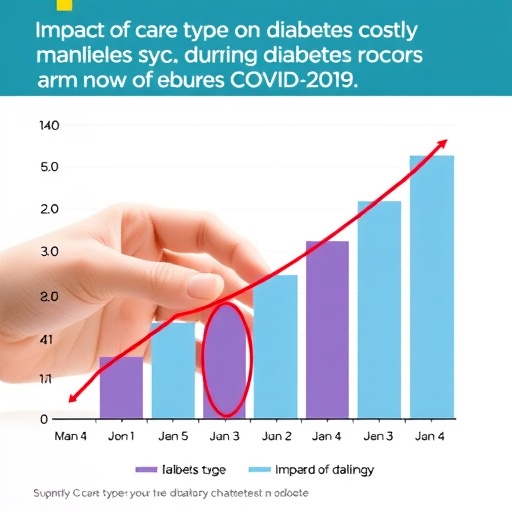Amid the sweeping changes brought by the COVID-19 pandemic, the landscape of healthcare has undergone significant transformations, particularly for vulnerable populations such as adults living with diabetes. A recent study delves deep into the patterns of medical expenditures among this demographic, contrasting data from 2019 to 2022 to unveil how the type and quality of usual sources of care (USC) have influenced healthcare spending during this unprecedented period. This research serves not only as a statistical analysis but as a vital indicator of the evolving relationship between healthcare accessibility and financial burden for patients.
In examining the pre-pandemic era, the study highlights how individuals with diabetes were navigating their care pathways. Prior to COVID-19, many adults relied heavily on established sources of care, frequently visiting clinics and hospitals that they considered their main providers. This period saw relatively stable medical expenditures as patients engaged with familiar healthcare systems, allowing for ongoing management of their diabetes. It was a time characterized by regular follow-ups, medication adherence, and a focus on preventative care strategies.
However, the onset of the pandemic in early 2020 dramatically altered how healthcare was delivered and perceived. With lockdowns and social distancing measures in place, many individuals found themselves hesitant to seek in-person medical appointments due to fears of contracting the virus. The disruption to regular care not only changed patient behavior but also imposed additional burdens on healthcare systems, which were overwhelmed with COVID-19 cases. For those with chronic conditions like diabetes, the ramifications of delaying care became palpable, leading to a spike in medical expenditures as patients eventually required more intensive interventions.
The study meticulously analyzes data sourced from the Korea Health Panel, showcasing how variations in USC type—such as private clinics, public health centers, and hospital systems—had differing impacts on spending. For patients associated with high-quality care facilities, expenditures remained more manageable during the pandemic, primarily due to these facilities’ ability to quickly adapt and implement telemedicine solutions. Conversely, individuals reliant on lower-quality sources of care faced substantial financial strain as they dealt with acute complications stemming from interrupted management of their conditions.
An essential finding of the research indicates that the quality of care was directly correlated with financial outcomes. Those who maintained their connections with trusted healthcare providers—who were swift in pivoting to telehealth options, for instance—report lesser increases in their medical bills. This speaks volumes about the importance of continuity in care, especially for conditions requiring ongoing monitoring and treatment like diabetes. The study thereby emphasizes that quality must be prioritized not just for patient satisfaction but also for economic sustainability in healthcare.
Furthermore, the investigation extends beyond simply recording expenditures; it probes into patient experiences during these challenging times. A narrative emerges from the data showcasing resilience among patients who employed various coping strategies to mitigate rising costs. Some opted to switch medication regimens based on availability, while others engaged in more frequent communication with their healthcare providers through digital means, illustrating adaptability amidst adversity.
Notably, this research underscores the critical importance of addressing healthcare disparities that were exacerbated during the pandemic. Many individuals, particularly those in lower socioeconomic brackets, faced heightened obstacles to accessing care. A significant portion of the cohort reported avoiding care due to concerns over costs or transportation challenges, underlying a systemic issue in healthcare access that necessitates concerted policy efforts.
The role of public health initiatives also can’t be overstated in this context. During the pandemic, proactive outreach and education from public health officials became vital in guiding patients with chronic conditions like diabetes on how to seek care safely. The study suggests that integrating public health strategies with healthcare service provision could bolster patient outcomes and potentially standardize care quality, hence reducing future expenditures.
As we progress beyond the immediate impacts of the pandemic, the findings from this research prompt significant questions about the future of healthcare given the persistent challenges of chronic disease management. Will healthcare systems learn and evolve from the lessons imparted by this crisis? Or will existing disparities remain entrenched, with vulnerable populations continuing to bear the heaviest burdens?
With the ongoing development of healthcare policies, stakeholders across sectors must take heed of these insights. The pandemic has crystallized the notion that situational awareness and quick adaptability in healthcare can lead to better patient outcomes. This should guide future frameworks aimed at improving the quality of care and reducing the financial strain on patients.
In summation, the study by Shin, Kim, and Lee provides a comprehensive examination of medical expenditures for adults with diabetes before and during the COVID-19 pandemic. The meticulous analysis not only enriches our understanding of healthcare dynamics during a crisis but also lays groundwork for essential discussions on how to enhance care systems moving forward. Ensuring equitable access to high-quality care will be paramount as we strive toward a more resilient healthcare framework capable of withstanding future challenges.
Subject of Research: Medical expenditures in adults with diabetes before and during the COVID-19 pandemic.
Article Title: Effects of the type and quality of usual source of care on medical expenditures in adults with diabetes before and during the COVID‑19 pandemic: a panel data analysis using the Korea Health Panel (2019–2022).
Article References:
Shin, HY., Kim, K., Lee, HY. et al. Effects of the type and quality of usual source of care on medical expenditures in adults with diabetes before and during the COVID‑19 pandemic: a panel data analysis using the Korea Health Panel (2019–2022).
BMC Health Serv Res 25, 1369 (2025). https://doi.org/10.1186/s12913-025-13518-7
Image Credits: AI Generated
DOI: 10.1186/s12913-025-13518-7
Keywords: Diabetes, COVID-19, healthcare expenditures, source of care, public health policy.




